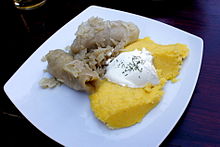Transylvanian cuisine
The traditional Transylvanian cuisine is based on the foods found and grown in the Transylvanian Basin and the Carpathian Mountains . The main grains to be mentioned are rye , corn and wheat , potatoes are mainly grown in Burzenland ( Țara Bârsei ). Vegetable cultivation is mainly found in urban communities. Fruit and especially viticulture is carried out in the Kokeltal ( Podișul Târnavelor ). In animal husbandry, cattle and pigs play the most important roles.
Influences on the Transylvanian cuisine
The regional cuisine is shaped by the eating and preparation habits of the Romanians , Magyars (including Szekler ) and Romanian Germans - mostly Transylvanian Saxons - living in Transylvania . Since the Romanian , the Hungarian and the influence of the Austrian cuisine are quite different, there is no uniform Transylvanian cuisine that is equally shared by all residents . However, a clear assignment of eating habits according to ethnic groups is a schematic that is far from everyday life. Access to shopping is likely to play an important role in the current eating habits of the population, which means that the cuisine of the urban and rural populations may differ greatly.
- The Romanian population usually serves a starter such as the salată de boeuf , a Țuică (schnapps, usually made from plums), which is supposed to act as an “appetizer”. With the exception of the chicken soup , all soups , the ciorbe , are usually lightly acidified with vinegar or borş - a juice fermented from wheat bran, rye and sugar beet. Worth mentioning are the ciorbă de perișoare ( vegetable soup with meatballs ), the ciorbă de burtă ( tripe soup ), the ciorbă țărănească ( farmer's soup ). The main dishes such as roasted pork, beef or lamb are usually served with mămăligă ( corn porridge ) or possibly fried potatoes , as well as white bread (the so-called wake ). The mămăligă itself is offered with various dairy products, especially the burduf . Mititei (also called mici for short ), minced meat rolls similar to Ćevapčići, are grilled . Since in Transylvania the food is higher in fat than in Western cuisine, air-dried or smoked bacon is often eaten with bread and onions . When frying meat or vegetables in the pan, the food is usually fried in lard and not in oil. Garlic is widely used in Romanian cuisine. Among the spreads are the zacuscă , the salată de vinete (an eggplant spread). The Cozonac is served on public holidays . And the colivă is eaten by the Orthodox population on various religious occasions. At Easter there is usually lamb (from lambs between 10 and 14 kg) and the drob , at Christmas sarmale ( cabbage wraps ) are common.
- The popular goulash in all its variations as well as the stuffed peppers originate from the Hungarian cuisine in the Transylvanian cuisine . Among the sweets, the Dobostorte , the Lángos , the Grammelpogatscherl and the pancakes should be mentioned . The Baumstriezel probably comes from the Hungarian Szeklerland, but is traditionally also eaten by the Transylvanian Saxons.
- Due to the Romanian Germans living in the region, influences of Austrian cuisine have also spread widely. Sofinden is noodle soup , semolina dumpling soup , vegetable soup , lentil stew and potato soup . The latter is often made with roux and tarragon . In addition to the air-dried or smoked pork bacon, which used to be stored in the spar towers of church or farm castles, bratwurst (with garlic), cooked sausage, is eaten. Greave lard with fried grammes is used as a spread. The potato bread baked in wood ovens is called house bread by the Romanian Germans . The confectionery includes Striezel , Hanklich (in different variations), cream slices and numerous types of fine baked goods , the recipes of which the Romanian German population took from German cookbooks.
As a result of the centuries of coexistence and coexistence of the Transylvanian population groups and the resources available in everyday life, eating habits have largely mixed up. Because of the religious differences, the Romanians are traditionally Orthodox, the Magyars mostly Catholic or Reformed , the Romanian Germans Protestant - the eating habits on church occasions and festive days have only mixed slightly. For example, only the Romanians prepare the colivă, but not tree stripes. For the Romanian Germans, Hanklich and Baumstriezel are the pastries that should not be missing at family celebrations.
See also
literature
- Martha Liess: Cookbook. Technical Publishing House, Bucharest 1957.
- Martha Liess: Transylvanian cookbook. Schiller, Hermannstadt / Bonn 2007, ISBN 978-3-941271-07-4 .
- Brigitte Ina Kuchar: Transylvanian cuisine . Schiller, Hermannstadt 2011, ISBN 978-3-941271-46-3
- Olga Katharina Farca: The cookbook of the Transylvanian Saxons with a historical overview . Farca, Villingen-Schwenningen 2014. ISBN 978-3-9803759-7-9
- Sanda Marin (actually Cecilia Maria Simionescu ): Carte de bucate , first published in 1936 by Cartea Românească
- Silvia Jurcovan: Carte de bucate pentru tinerele gospodine . Editura tehnică, Bucharest 1975; Carte de bucate Editura Tehnică, Bucharest 1983 and Bucharest 2003 (at WorldCat ; ISBN 973-31-2159-2 )
Web links
Individual evidence
- ↑ Sanda Marin: Carte de bucate at celendo.ro ( Memento from March 4, 2016 in the Internet Archive ) PDF (Romanian)
- ↑ Recipe for "drob" at vulpeabucatar.com (English)




